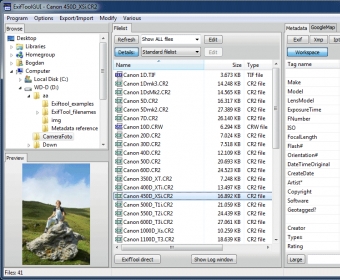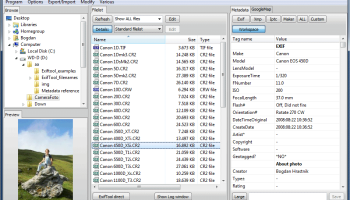

If no TITLE is given, a default TITLE string of "ExifTool %p%%" is assumed. progress:), the console window title is set according to the specified TITLE string. When combined with the -if option, the total count includes all files before the condition is applied, but files that fail the condition will not have their names printed. Implies the -v0 option, causing the names of processed files to also be printed when writing. Without a colon, the -progress option adds a progress count in brackets after the name of each processed file, giving the current file number and the total number of files to be processed. You can add -Recurse to Get-ChildItem $FolderPath -Filter *.* | so it would be Get-ChildItem $FolderPath -Filter *.* -Recurse | to look at all files in all - to show progress, you can use the 'progress' feature of exiftool as documented in the exiftool 'pod' Or you can change it to Write-Host "$_" if you only want the file name. Obviously you can remove the Write-Host "$FileName" (file path and name) if you just want a list of coordinates. # Convert them to Degrees Minutes Seconds Ref # Read your desirered metadata, if it doesn't contain any, say NONE # Get the file name and path, write it out to screen Get-ChildItem $FolderPath -Filter *.* | where | It's not the tidiest, but it's self explanatory: cls

Using and answers, I came up with the following to run through all files in a folder. Write-host $n, " " $photo.CreateDate, $photo.GPSLatitude, $photo.GPSLongitude $data = (exiftool -if '$gpsdatetime' -s -s -s -json -ext jpg -filename -FileTypeExtension -Directory -CreateDate -GPSDateTime -GPSLatitude -GPSLongitude -n -r $photoYear ) | ConvertFrom-Json Only at the end does it give a summary: # $photoYear is the root folder with the images

One little thing: this exiftool option set gives no "feedback" when running. Here's the key snippets of the code (below). As I became more confident with JSON that toolset became more obvious for me. I have used it before and it's excellent. I will try Exiftool to see if it's easier. In-camera value says -37.8622 and taken at 10:42:10 local, so happy with that, including the '-' for South # So final latitude is 37 deg 51 min 43.92 sec S This is a subset easy to copy in GpsLongitude for the other one :-) $('GpsLatitude').Value.Value $image = New-Object -ComObject Wia.ImageFile # Create an ImageFile object and load an image file To help others, here's what I discovered: # Based on answer from (above) Thanks to everyone, particularly I've learned a lot and managed to work out how to extract my exact values, including the important N,S,E,W.


 0 kommentar(er)
0 kommentar(er)
